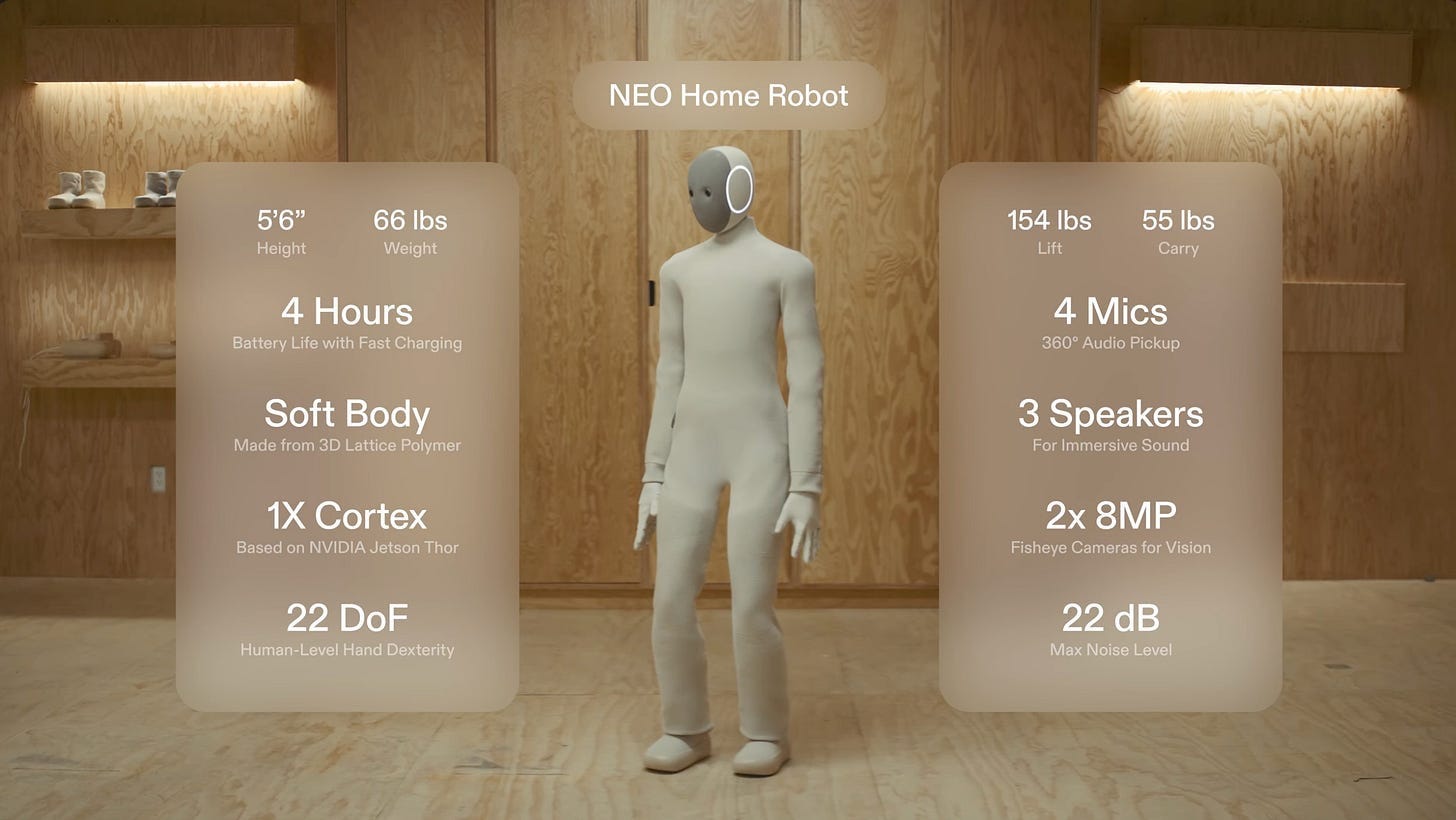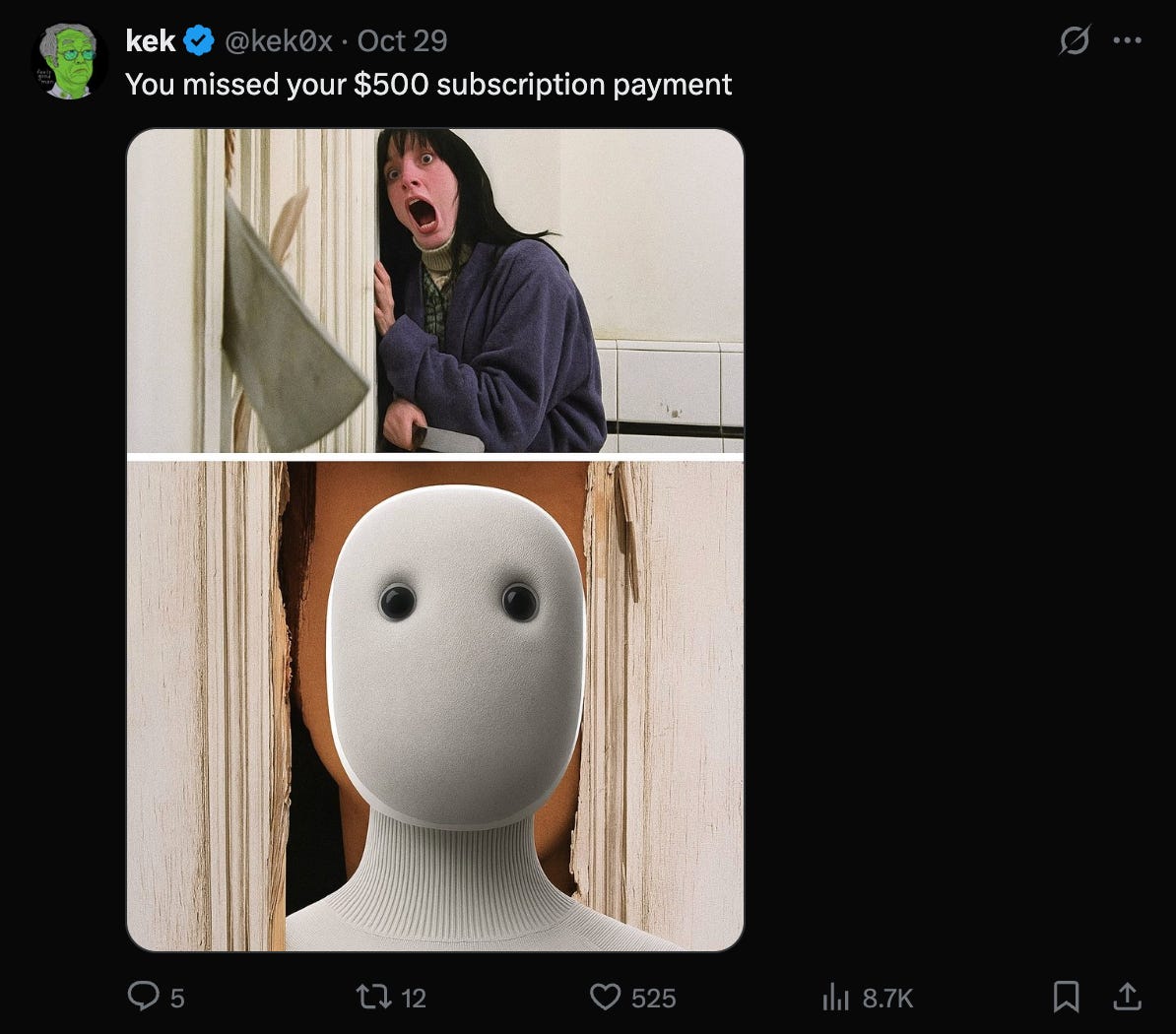NEO Home Robot: launch before you're ready?
Last week’s NEO home robot launch from 1X Technologies kicked off a juicy product question: should you launch before you’re ready?
Last week’s NEO home robot launch from 1X Technologies kicked off a juicy product question: should you launch before you’re ready?
The keynote vs. the reality
1X’s keynote promised plant-watering, decluttering, vacuuming, laundry, and dishwasher loading.
But WSJ’s Joanna Stern stress-tested NEO and surfaced how often a remote human had to step in. In its current state, all the tasks in the video were completed via human teleoperation (remote operators “drive” NEO to finish chores).

And we saw how painfully slow this can be: loading 2 glasses and a spoon into a dishwasher took 5 minutes…
and watching NEO try to close the dishwasher was just…
UNCOMFY 😂
But by far the biggest problem with the NEO Robot are the privacy concerns, which understandably makes most people on edge. With the remote operator functionality, you’re basically letting a call center put a live feed into your home.
In short, the technology looked nowhere near “ready”, but you can pre-order Neo now for a $20,000 flat fee, or a $499 monthly subscription fee. (Hey, at least they give you the option to skip the subscription!)
But even 1X’s CEO, Bernt Børnich, was candid about the road ahead:
“The Neo you’ll get today is only going to become more and more useful as we keep shipping new features. The journey there is not going to be perfect, and we’re not going to pretend it’s going to be.” -Bernt Børnich – Founder & CEO at 1X
As tech YouTuber Marques Brownlee pointed out, the keynote is more of an “art-of-the-possible” than a true product release.
So, this got me thinking:
is leading with a half-baked product a viable go-to-market?
Leading by press release?
Amazon became famous for the “working backwards” approach: product managers would write a press release as part of product proposals. This forced teams to concretely convey customer value and the future-state vision of the product.
But importantly, the press release was typically used as an internal tool for alignment.
Today’s product launches invert that model: announce early, ship incrementally, co-create with customers, and let real-world usage train the system.
This modern playbook was arguably normalized by ChatGPT’s 2022 Research Preview, which explicitly launched to “get users’ feedback and learn about its strengths and weaknesses.” (ah, how long ago this seems!)
And we now know how well this worked: ChatGPT effectively had 100 million testers within 2 months providing them with feedback to cover all the edge cases that their internal teams would take years to uncover.
What Product Builders need to know
Shipping before you’re “ready” can work if you:
Set expectations: be explicit about limitations and the roadmap to close gaps.
Instrument for learning: have reliable feedback mechanisms and a systematic way of categorizing feedback.
Find a willing customer base: customers should get clear value in exchange for providing feedback. In the case of ChatGPT, users were getting free access to a ground-breaking AI tool.
Communicate transparently & rapidly: be prepared for quick hot fixes, rapid feature iteration, and to communicate on-the-fly with your customer base.
Ship responsibly: shipping fast doesn’t mean compromising on quality: security, privacy, and other safety guardrails are increasingly important and shouldn’t be compromised on.
For a real life case study, check out this story I wrote about my work at Air Canada. We shipped before we were ready, but with the safeguards necessary to make it work.
The Story Behind Air Canada’s Redesign
This week’s post is a personal case study of how I enabled “Simple Mode” for a travel product: the Air Canada homepage.
Final Thoughts
Customers will be willing to go “along for the ride” as long as the early access version is valuable enough to them. In the case of NEO, it’ll be early-adopters who want to shape the future of household robotics.
“The next few years isn’t about owning a useful robot, it’s about raising one.”
-Joanna Stern, The Wall Street Journal
💬 Leave me a comment or reply to the email, would you let a home robot do your chores? Where do you draw the line?








